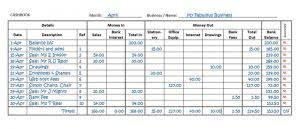Content

These must be deducted from stockholders’ equity, as they’re owned by the company. This figure is calculated by subtracting total liabilities from total assets; alternatively, it can be calculated by taking the sum of share capital and retained earnings, less treasury stock. Initially, at a corporation’s foundation, the amount of stockholders’ equity reflects how much co-owners or investors have contributed to the company in form of direct investments. The capital invested enables a company to operate as it acquires assets, hires personnel, and creates operations to market, produce, and distribute its products or services. Investors hope their equity contributions can be paid back to them through dividends and/or increase in shareholder value. Some investors may be repaid directly by the company via share buybacks. The stockholder’s equity is also known by other terminologies such as shareholders equity or share capital.
In the balance sheet, you will be able to see the assets, liabilities, and shareholders’ equity of the company during the reporting period. It is also known as the statement of financial position or the statement of net worth.
Preferred Stock
Over 80 years ago oil prospectors also known as wildcatter’s named Bill and Steve gathered up all of their savings and purchased a piece of land in Texas. Both Bill and Steve each invested $1000 because they suspected that the land they were purchasing contain oil underneath the ground. Bill and Steve both agreed to share the profits and they became equal partners in this business venture. They began to drill for oil book and but could not find anything so they hired an old wildcatter name Jack who was a self-proclaimed expert at finding oil in the area. Bill and Steve had both spent their entire savings on purchasing the land and they had no money to pay Jack with for his help.
Is retained earnings a equity?
Are Retained Earnings a Type of Equity? Retained earnings are a type of equity and are therefore reported in the shareholders' equity section of the balance sheet. Although retained earnings are not themselves an asset, they can be used to purchase assets such as inventory, equipment, or other investments.
If assets are greater than liabilities, then the equity accounts contain a positive balance; if not, they contain a negative balance. The stockholders’ equity accounts normally have credit balances, and so are located on the balance sheet immediately after the liability accounts, and in opposition to the asset accounts. Treasury shares or stock (not to be confused with U.S. Treasury bills) represent stock that the company has bought back from existing shareholders. Companies may do a repurchase when management cannot deploy all of the available equity capital in ways that might deliver the best returns.
What Is Stockholders’ Equity?
Stockholders’ equity is the value of a company’s assets that remain after subtracting liabilities and is located on the balance sheet and the statement of stockholders’ equity. The $1,000,000 deducted from total stockholders’ equity represents the par value of the preferred stock as the preferred stock is not callable.
For this reason, many investors view companies with negative shareholder equity as risky or unsafe investments. Shareholder equity alone is not a definitive indicator of a company’s financial health. If used in conjunction with other tools and metrics, the investor can accurately analyze how to calculate stockholders equity the health of an organization. Venture capitalists provide most private equity financing in return for an early minority stake. Sometimes, a venture capitalist will take a seat on the board of directors for its portfolio companies, ensuring an active role in guiding the company.
Equity for Shareholders: How It Works and How to Calculate It
A statement of stockholders’ equity is another name for the statement of shareholder equity. This section of the balance sheet is also known as a statement of shareholders’ equity or a statement of owner’s equity. It gives shareholders, investors or the company’s owner a picture of how the business is performing, net of all assets and liabilities. The statement of stockholders’ equity is the difference https://www.bookstime.com/ between total assets and total liabilities, and is usually measured monthly, quarterly, or annually. It’s found on the balance sheet, which is one of three financial documents that are important to all small businesses. Preferred stock, common stock, additional paid‐in‐capital, retained earnings, and treasury stock are all reported on the balance sheet in the stockholders’ equity section.
Amount, after unamortized premium and debt issuance costs, of long-term debt, classified as current. Includes, but not limited to, notes payable, bonds payable, debentures, mortgage loans and commercial paper.
The Struggles of Private Company Accounting
Shares bought back by companies become treasury shares, and the dollar value is noted in an account called treasury stock, a contra account to the accounts of investor capital and retained earnings. Companies can reissue treasury shares back to stockholders when companies need to raise money. The statement of stockholder’ equity provides users with information regarding the change in a stockholders’ equity of a corporation. The retained earnings can be thought of as a pool of cash that future dividends of a business could be paid from. When a business has incurred losses rather than made a profit then it has negative retained earnings that are also referred to as the accumulated deficit. The changes in the value of shareholders equity and the resulting effects are listed below. Share capital includes all contributions from the company’s stockholders to purchase shares in the company.
